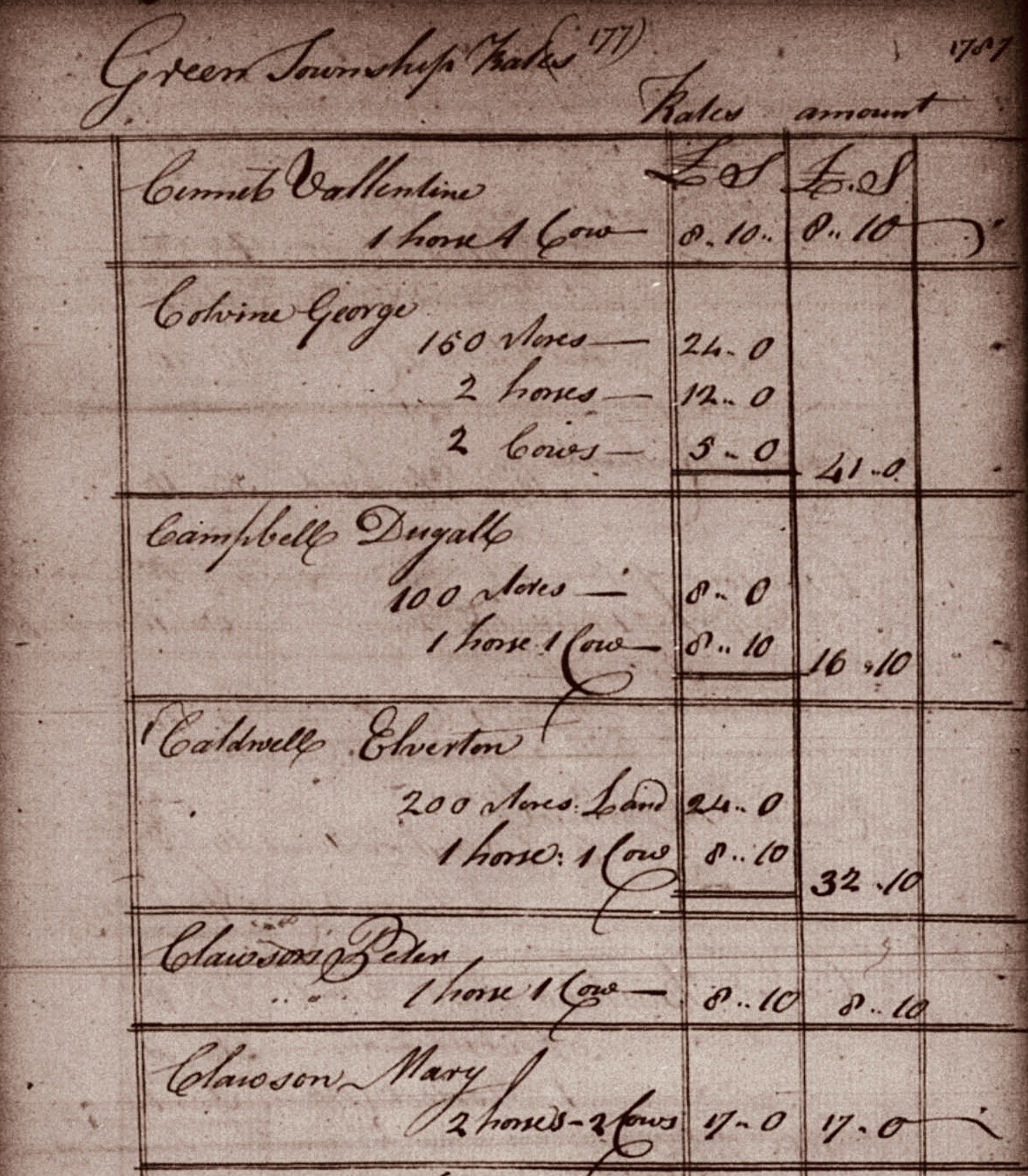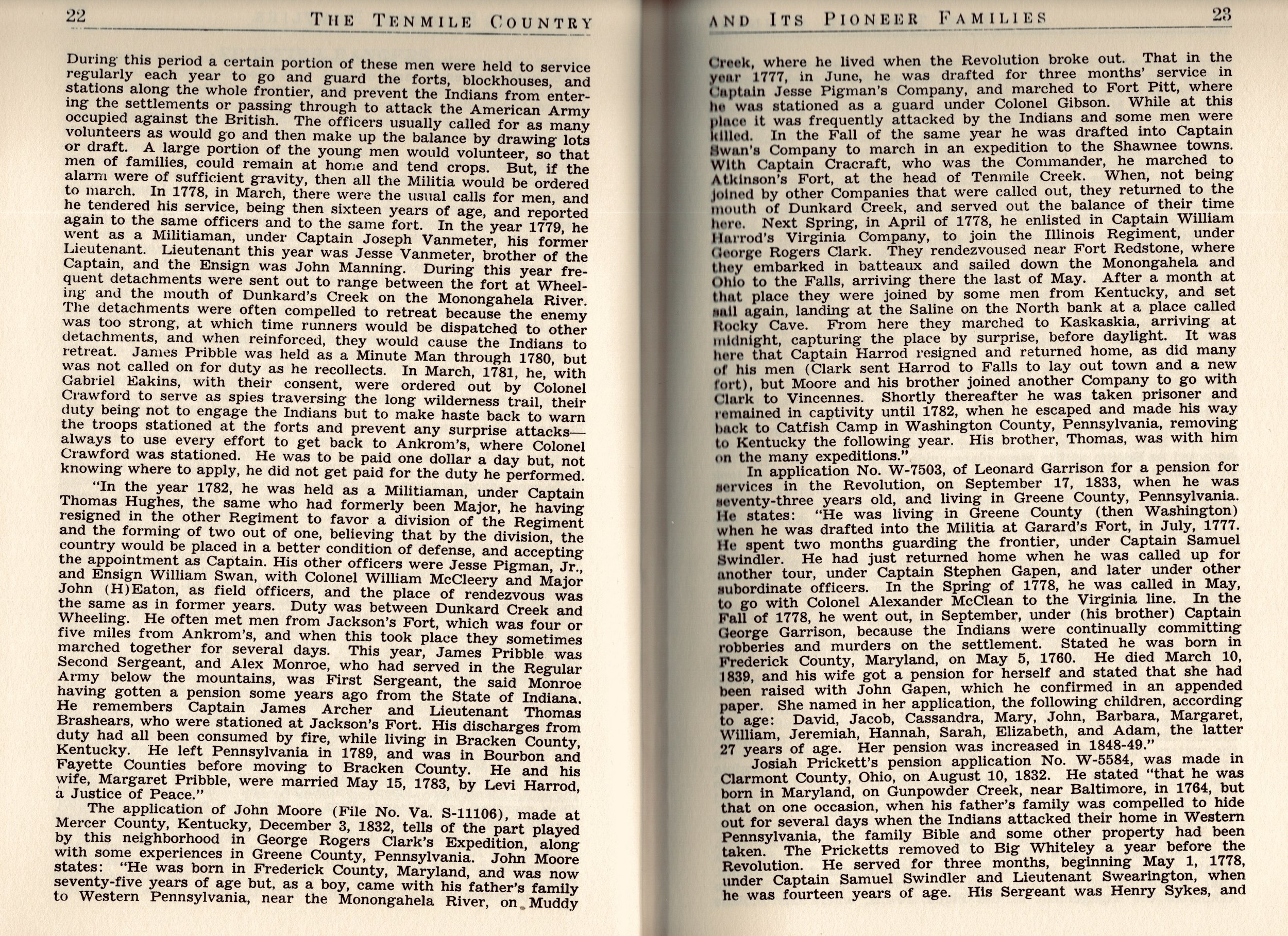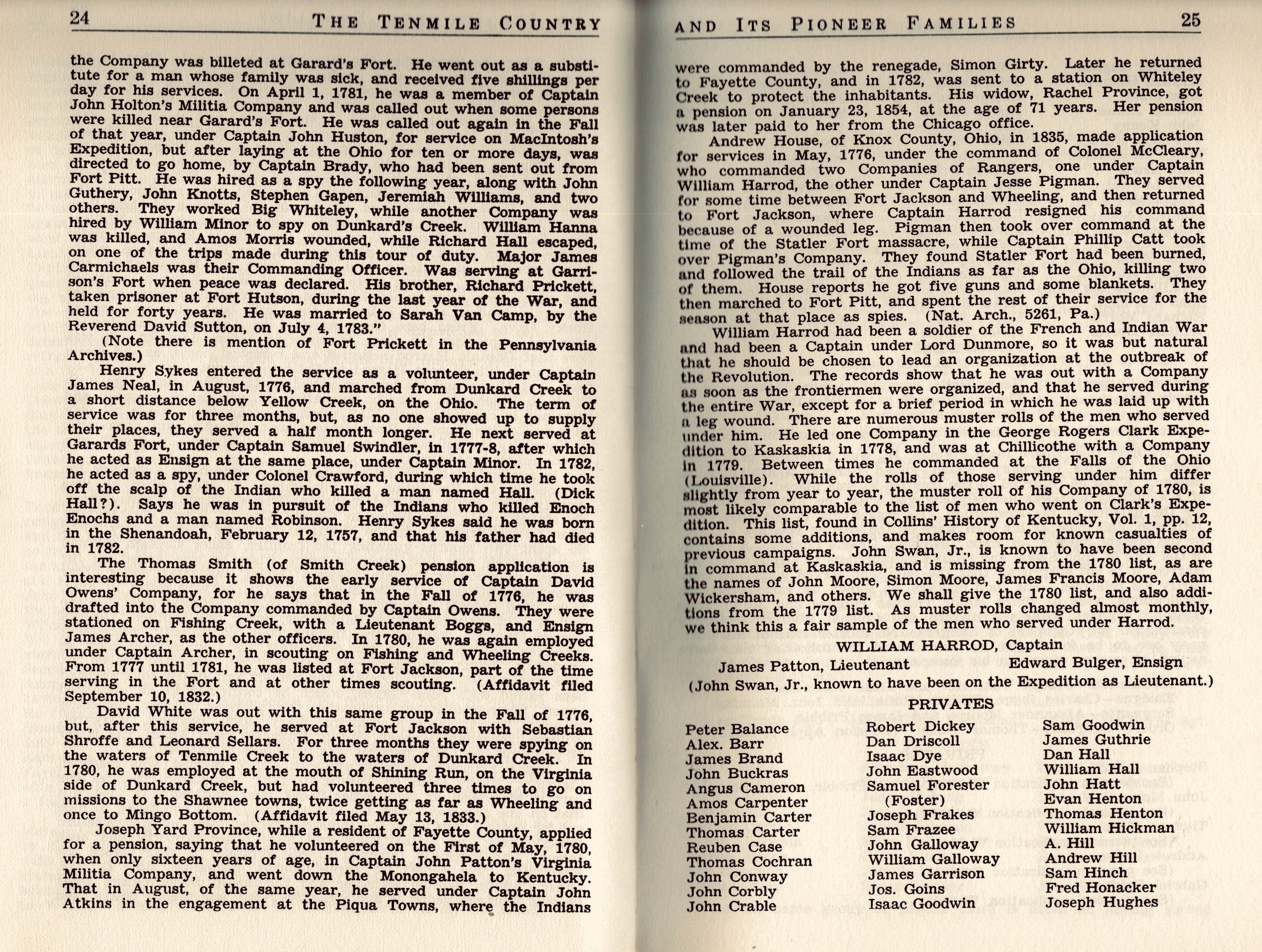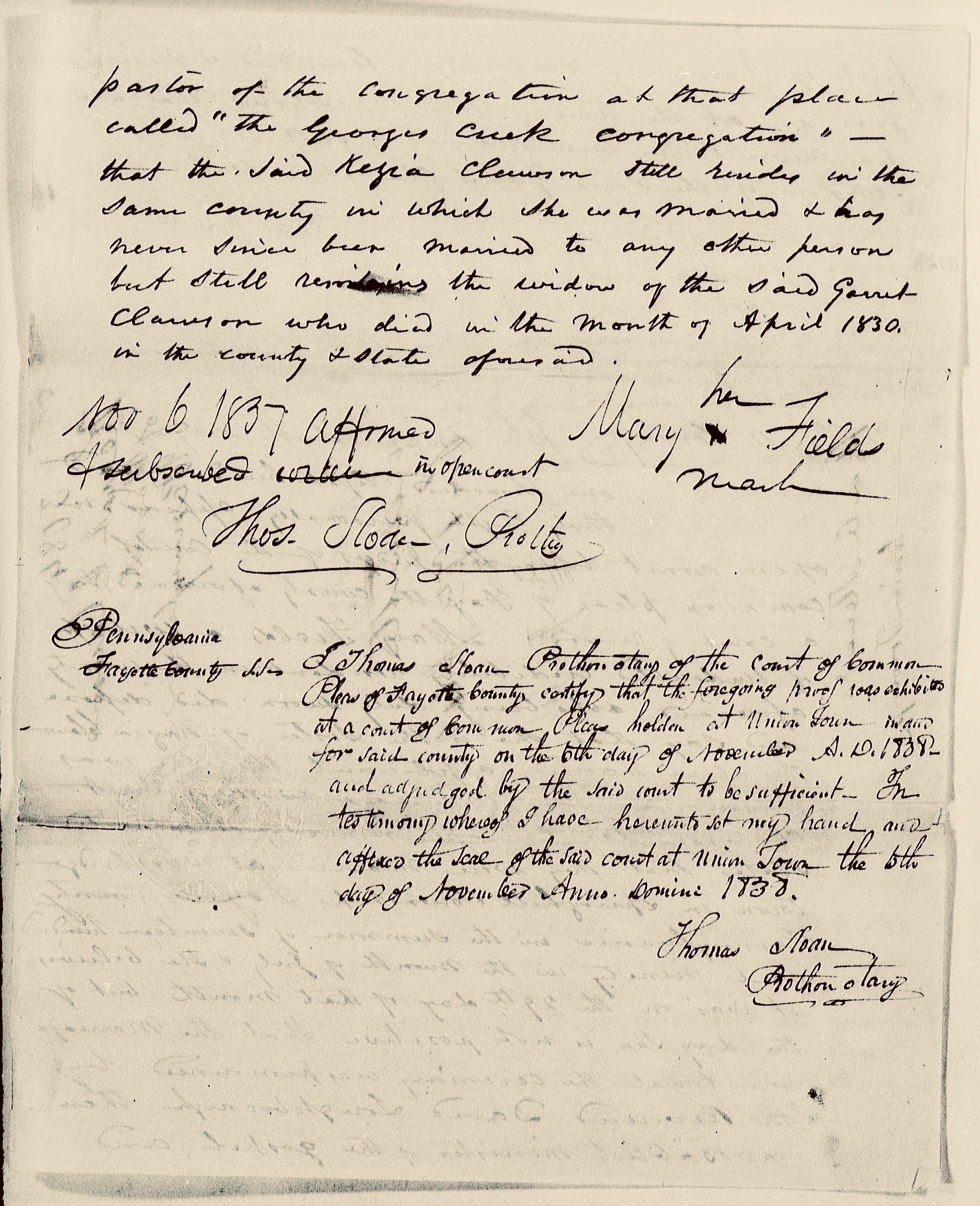In the actual executive council minutes, there’s a longer list of those reimbursed for their scouting activities during 1782 (Supreme Exec Council v 15 p. 31), which represents the “others” listed above: “An order was drawn upon the Treasurer in favor of Colonel James Marshall, Lieutenant of Washington county, for thirty-seven pounds two shilling and is pence, to be paid by him to Abraham Enslow, Frederick Crow, Stephen Gapin, Peter Clawson, William Crawford, Jesse Vanmetri, William Harrod, Sen’r, Michael Dougherty, John Flora, John Heaton, William Tarpine, Harrod Newland, Robert Flora, Alexander Bruce and Peter Daily, for their services in watching the movements of Indians, and protecting the settlements on the western frontiers from Indian depradations in the year 1782, agreeably to the act of Assembly, dated December 1781.” During a Salt Lake City family history library visit, I searched for the original record, but could not find it.
Stephen Gapen, one of the “spies” with Peter, submitted a statement on the pension application of Henry Sicks (Six - Sycks), who was not listed with the 1782 spies, but appears to have done it in that period of time. The statement describes what they did, and follows: Greene County. The Commonwealth of Pennsylvania Before me the subscribing Witness one of the Commonwealth Justices of the peace in & for the County aforesaid Personally appeared Stephen Gapen who after being duly affirmed as the law directs deposeth & saith that in the year 1781 or 1782 that Henry Sicks [sic] now of Greene County & State aforesaid – did act in company with the deponent as a volunteer spy against the Indians on the waters of Dunkard Creek about the line between Virginia & Pennsylvania the ground we ranged composing now a part of Mongaa [Monongalia] County in Virginia & a part of Greene County Pennsylvania the deponent states that he was with him one or two weeks the exact time not precisely recollected & further the deponent states that he knew the said Henry to be out as a spy at divers other times & further saith not, Sworn & subscribed September 1st 1834 before me S/ Richard Kerwood S/ Stephen Gapen
George Morris made a similar statement for Henry Six: The statement by George Morris: Greene County SS. Before me the Subscriber one of the Justices of the Peace in and for said County personally came George Morris of said County who on his solemn oath deposeth and saith that he well remembers that Henry Six [sic] of Monongahela Township in said County for forted at garard fort on Big Whitely Creek during the greater part of 2 or 3 Summers during the Indian war under Captain Swingler either as a volunteer or under a draft (he does not recollect which) was ready and willing at all alarms and at all times to pursue the Indians – and further saith not. Sworn and subscribed this 20th day of September 1834. S/ George Morris
Henry Sykes own statement from his pension on this time: Henry_Sykes_Rev_War_Pension_File – S6184 - Pension application of Henry Sykes (Sycks) f28VA Transcribed by Will Graves 5/31/12 – in other records (and in one place in this pension file, Henry is referred to as Henry SIX).
State of Penna, County of Greene: SS
On the 17th day of November in the year of our Lord 1834 personally appeared in open Court before the Honorable Thomas H Baird President and his Associates now sitting Henry Sycks [sic] a resident of the County of Greene aforesaid aged about seventy-eight years who being first duly sworn according to law doth on his oath make the following declaration in order to obtain the benefit of the act of Congress passed June 7th 1832. That he entered the service as a volunteer some time in August 1776 and him from the waters of Dunkard Creek and rendezvoused on the Ohio River some short distance below the mouth of Yellow Creek, my Captain's name was James Neel [James Neal] he then resided in what is now Fayette County, one term of service was to be three months, but as no persons came to supply our places, our officer requested us to stay longer and we stayed half a month, I have no recollection of the names of the other officers or names, I was out at that time four months lacking a few days. I next served one month at Garret's Fort on Big Whitely Creek under Captain Samuel Swingler, sometime in the year 1777 or 1778. I was at the time a sergeant in Captain Minor's Company of militia and we were all classed and took our respective times of doing duty, as it came to our turn. I next acted as an Ensign at the said Fort, for the space of upwards of a month, from a small scrap of paper that I have attached to this declaration on which I kept the account of the persons as they came into service their monthly tours, I must have acted in the capacity of Ensign for near six weeks. This service was in 1782. I was then appointed and acted as a Spy under Colonel William Crawford in which capacity I served for some length of time, while in that Capacity I found and took off the scalp of an Indian that was supposed to be killed by a man of the name of Hall, this fact I made an affidavit of sometime after to enable Hall to draw the reward for killing an Indian. In addition to the above services that deponent rendered under officers as above stated that deponent was off and on at Jerrats fort nearly every summer from the year 1776 till the year 1782. He also acted in the Capacity of Spy on the waters of Dunkard, for a number of Summers but the precise time from the length of time & deponent's old age deponent cannot state with certainty. But deponent is free in stating that the whole time he was engaged in the Indian War must have been upwards [of] two years, there are a number of circumstances to which deponent ought to refer of his voluntary services, one of which was the taking of one of his Sisters by the Indians and who was kept with them till after General Wayne's Treaty, deponent was at that time engaged against them he was also in pursuit of the Indians at the time of the killing of Robins on & Enoch Enochs where he with others pursued them in the direction of the Big River, but did not come up with them, in short he might say that the whole frontier was in a state of War during the summer seasons for years.
Conclusions on Military Records. Garret Clawson was in various military and revolutionary war records from 1776 through 1781. Looking at the records of the various units, they reconstituted themselves every year differently, but with similar leaders and similar membership. While the Revolutionary War was going on during this period, the priority in Greene Township were the raids by Native Americans and local defense.
Garret’s pension only mentions his Virginia revolutionary war service. But that is appropriate as the service by he, his brothers, and his neighbors were in “frontier ranger” units - that service not making them eligible for revolutionary war pensions. It is also significant that almost all of these units - both militia and revolutionary war - were associated with the State of Virginia, before the boundary dispute was settled.
However, Garret was in a Maryland unit in 1776, and that should have been included as service in his pension application.
Given his birth in December 1759, Garrett would have been of the age of sixteen through twenty-two years old in the time of these various service records. While there is no smoking gun indicating whether there were one or two Garret’s in this period - circumstantial evidence seems to indicate that these records were all of the same Garret. Peter Clawson would have been the oldest son of Mary, and would likely have been home with her and able to defend and allow Garret to serve. By the time that both John and Peter were shown in militia and spy units in 1782, the Clawson brothers were all coming of age.
It should be noted that when John Clawson was shown in the Guthrey militia unit he was just sixteen or seventeen. So if there was a question of whether Garrett was old enough to serve in the 1776 militia unit - he was the same age.
Overall, while there is no smoking gun, it appears that it was the same Garret that appeared in the military records of this period - and there was no Garrett Sr. as a husband of Mary.
Clawson Family in PA Tax and Census Records 1781-1790
1781-1789. Washington County Tax Records. Once the border dispute was settled between Pennsylvania and Virginia, Washington County was formed in Pennsylvania in March 1781. Greene Township, later Greene County (formed in 1796 after the Clawsons had left) was where the Clawsons lived prior to going to Ohio ca 1790. With the new county formed, taxes were assessed and recorded. Clawsons were recorded in the Washington County tax records from when they were first taken in 1781, until 1789 - the last year the Clawsons were in Greene Township before going to frontier Ohio, and the last year where these records were recorded in Washington County during this period.
Yet some land was granted while this area was claimed by Virginia. Once this land was recognized as part of Pennsylvania, the process for patenting land in Pennsylvania was a little slower - with many patents not being executed until the mid or late 1780’s, even though residents had been living on the land the entire time. Therefore, the tax records below show taxes paid on land - for example Mary Clawson shown just below as being taxed on 100 acres in 1781 - even though there is no apparent record that she ever applied to own that land. While some of the Clawsons were shown with land in the tax records, only Thomas had a completed warrant for land. He and his brother Garret applied on the same day in October 1787, but Garret walked away from that patent in short order and ended up in Fayette County. Peter Clawson was also taxed for land in this period, and is named as an adjoining land owner in the Garret Clawson warrant, but never applied to own the land.
Originally, it was thought that only records from the year of 1784 and 1785 survived from this period. They were chronicled in a 1955 publication of the Washington Co. (PA) Chapter of the DAR. In 1982, a duplicate copy of the original tax records were found “by accident” in Harrisburg and have been made available for research. I have scanned the records for 1781 through 1789, and posted the pages by year below - with the records that contain a member of the Clawson family.
The records are organized by township, and the Clawsons were shown in just one in this period, so there won’t be a reference to any township other than Greene. Unfortunately, the records were alphabetized by letter, so it does not indicate who was living by each other. The records generally list items such as acres of land, horses, and cows - as a basis for the taxation, and then the amount of taxes is listed. In many years, there is a separate category for “single men”, which is important for our family, because many of the Clawson sons came of age in this decade and are shown in the “single men” section.
Within these records in this period was also an issue of tax exoneration. Due to Indian attacks in some years, when some of the residents were even driven from their homes, taxes were exonerated – or remitted to the taxpayer – if they were on an exoneration list. It’s unclear to me what the qualification was to be on the exoneration list. The 1988 book on Washington County tax records indicated that all 1782 taxes on Washington County taxes were exonerated by a legislative act in December of 1781. In 1783, all residents were again exonerated, except a few in the Fallowfield area. It appears a large amount of County residents were again exonerated in 1789. It is clear from the records below that Mary Clawson was exonerated in 1782 and 1783. The listing for 1789 does not appear to list exoneration. I have a mention of exoneration in another year, but no evidence for it and it is possibly an error. But it does confirm another way that the Clawsons were in a white settler interface with Native Americans that existed for the time they were in this area.
The handwriting in some of the records is not always clear – in one reading of these records I thought that a John Choffin was arguably John Clossin or Clossen. The handwriting issue is made more difficult by the fact that entries that we know are our family are spelled at least five different ways – Clasen, Closen, Clousen, Clauson, and Clawson. Additionally, there are related people in these records In some of the records, I mention Abraham Covalt - listed in the “C’s” in Greene Township with the Clawsons - whose daughter Thomas would marry once they were all in southwest Ohio, living in a fort named for Covalt. Additionally, there are records in some of these years for members of the Garrison family, significant because Peter Clawson married Dolly Garrison of this family during this period. In the Fayette County tax records showed Garrett Clawson with Thomas Gaddis, in whose militia unit he served.
With all that background, the tax records are posted by year below - in Greene Township, one in Springhill Township, Westmoreland County in 1783 (placed in Fayette County at the end of that year) showing Garrett, and a few showing Garrett in Springhill Township, Fayette County.
Additionally, Pennsylvania conducted a state census in 1786, and the first United State Census was conducted in 1790. To the extent any of our Clawson family members were in these censuses, they will be posted below in this section by date.
1781. The image of the top of the first page is torn – it states “The Effective . . “ and then the page is torn, but it is likely the beginning name of the tax. It also appears to name Zachariah Gapen as the Assessor. Zachariah’s son Stephen was a neighbor of the Clawsons and was in the Gaddis military unit with Garret, and was a frontier spy later with Peter Clawson.
The headings for this year are acres of land, horses, cows, sheep, slaves, stills, mills and total valuation. Mary Clawson is shown with one hundred acres, one horse, one cow, and twenty-two of valuation. Six lines above her was an entry for Abraham Covalt.






































































































